The saga of navigation on Lake Ontario and the St. Lawrence River, in war and peace, is far too vast and rich a subject for an article. Shipbuilding on both sides of the border likewise is a substantial topic, about which books already have been written. This presentation had intended to focus more on the origin of the Thousand Islands boat tour—an institution now more than 130 years old--but the the articles became amplified historically by fascinating material, at least for boat lovers.
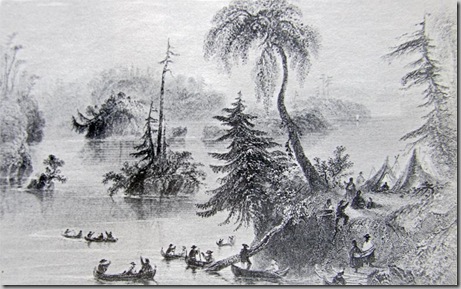
Engraving by Bartlett, c. 1840.
Visitors viewed the Thousand Islands long before local boat tours provided access to sightseers. The St. Lawrence River had been a major transportation route for centuries, even during the sixteenth and seventeenth centuries—Cartier came from St. Malo, France, in 1534 and named the river the following year. Champlain sailed the river in 1615. Father Simon LeMoyne passed through in 1659, followed by many other Jesuit missionaries. The first detailed description was penned in 1665-1666 by de Courcelles and de Tracy, on an expedition against the Mohawk Indians:
"But when the mouth of the Great Lake is reached, the navigation is easy, when the waters are tranquil, becoming insensibly wider at first, then about two-thirds, next one-half, and finally out of sight of land; epecially after one has passed an infinity of little islands which are at the entrace of the lake in such great number, and in such a variety, that the most experienced Iroquois Pilots sometime lose themselves there, and have considerable difficulty in distinquishing the course to be steered, in the confusion, and, as it were, in the labyrinth formed by the islands, which othewise have nothing agreeable beyond their multitude. For these are only huge rocks rising out the water, covered merely by moss, or a few spruce or other stunted wood, whose roots spring from the clefts of the rockes which can supply no other aliment or moisture to these barren trees than what the rains furnish them. After leaving this melancholy abode, the Lake is discovered, appearing like unto a sea without islands or bounds, where barks and ships can sail in all safety so that the communications would be easy between all the French colonies that could be established on the borders of this Great Lake which is more than a hundred leagues long, by thirty or forty wide."
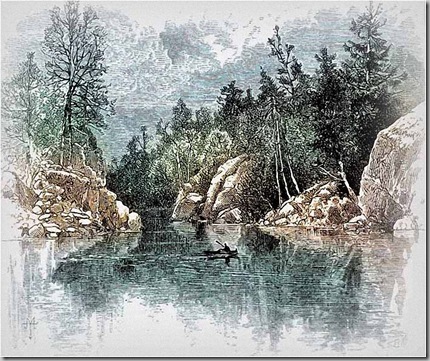
Entrance to the International Rift. Howard Pyle, artist.
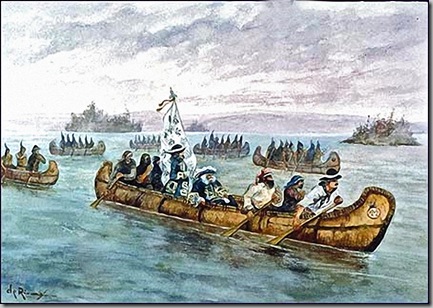
Frontenac en route pour Cataraqui. John Henry de Rinzy.
Archives Nationales du Canada (C-13325)
Count Frontenac came in 1669, building Fort Frontenac at Cataraqui (Kingston) in 1673, occupied by La Salle that year, who rebuilt it three years later. The first European who accomplished the river ascent of the St. Lawrence from the Atlantic to Lake Ontario was M. de Courcelles, in 1670 (whose earlier account appears above).
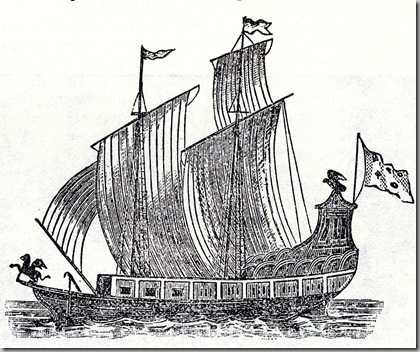
La Salle's Griffon.
The first sailing vessel built on Lake Ontario was a small schooner of about ten tons burden, constructed at the "Cabins," at modern Kingston. La Salle sailed from Cataraqui (Kingston) on this vessel on November 18th, 1678. His destination was the mouth of the Niagara River. His vessel carried both merchandise and the materials for constructing another ship, probably the Griffon.
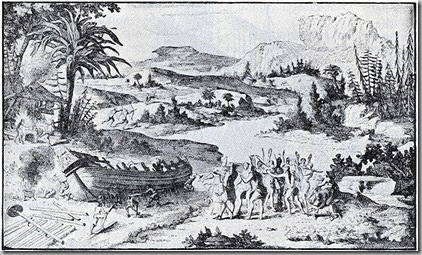
Building the Griffon.
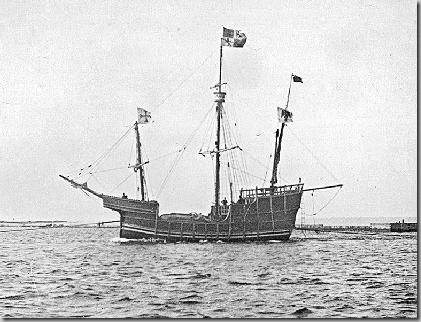
Reconstruction of the Griffon, built in 1679 for Cavelier de La Salle, the first sailing ship on the Great Lakes, described as "a kind of brigantine, not unlike a Dutch galliot, with a broad, elevated bow and stern, very flat in the bottom, looking much larger than she really was and of sixty tons burden."
At the mid-eighteeth century the British built their first ships on Lake Ontario--a fleet launched at Oswego in 1753. After recapture of Fort Oswego from the French they discovered a ship-building yard there with "nine vessels of war." Ships proliferated on the lake and river during the eighteenth century. The British built the 22-Gun Brig-Sloop Ontario at Carleton Island shipyard in 1780.
Irishman Isaac Weld, Jr. traveled by bateau. The boats' shallow draft was an advantage while its flat bottom profile allowed heavy loading of cargoes and provided stability. The smallest bateau required only one crewman, while larger ones required up to five and reach up to 45-58 feet (14-17.5 meters) in length. The largest bateaux could carry two to ten tons of cargo.
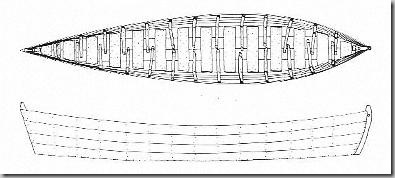
A 1758 military batteau.
Bateaux could mount a small sail although the flat bottom was not optimal for sailing. In military records, it is seen that the boats were propelled primarily by oars with one oar being used at the stern as a rudder. Isaac Weld, Jr. wrote his description of the “Lake of the Thousand Islands” in 1796:
"We accordingly proceeded, but towards midnight the wind died away. This circumstance, however, did not alter the determination of the conductor. The men were ordered to the oars, and notwithstanding that they had labored hard during the precdeding day and had no rest, yet they were kept closely at work until day-break, except for one hour, during which they were allowed to stop to cook their provisions.
"Where there is a gentle current, as in this part of the river, the Canadians will work at the oars for many hours without intermission; they seem to think it no hardship to be employed in this instance the whole night; on the contrary,, they plied as vigorously as if they had but just set out, singing merrily the whole time. They have one very favorite duet amongst them, called the 'rowing duet,' which as they sing they mark time to, with each stroke of the oar; indeed, when rowing n smooth water, they mark the time of most of the airs they sing in the same manner.
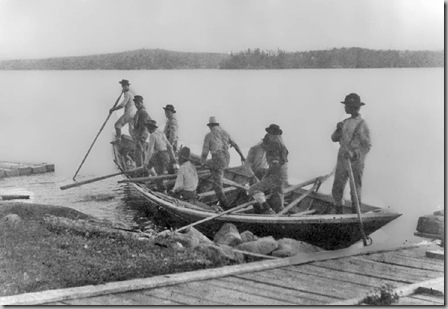
Replica rowing-type bateau. Courtesy St. Lawrence Islands National Park.
"About eight o'clock in the next, and eighth morning of our voyage, we entered the last lake before you come to that of Ontario, called The Lake of a Thousand Islands, on account of the multiplicity of them, which it contains.
"Many of these islands are scarely larger than a bateau, and none of them, except such as are situated at the upper and lower extemities of the lake, appearing to me to contain more than fifteen English acres each. They are all covered with wood, even to the very smallest. The trees on these coasts are smaller in their growth, the larger islands produce as fine timber as will be found on the main shores of the lake. Many of these islands are siituated so closely together, that it would be easy to throw a pebble from one to the other. Notwithstanding which circumstance, the passage between them is perfectly safe and commodious for bateaux, and between some of them that are even thus close to each other, is water sufficient for a frigate. The water is uncommonly clear as it is in every part of the river from Lake St. Francis upwards, between that lake and the Utawas [Ottawa] River downwards it is discolored, as I have observed, by passing over beds of marl.
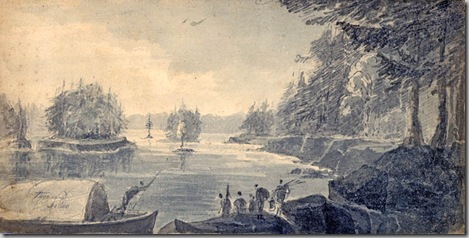
Thousand Islands, July 26, [ca. 1796]. Elizabeth Simcoe. Archives of Ontario.
"The shores of all these islands under our notice are rocky; most of them rise very boldly, and some exhibit perpendicular masses of rocks towards the water, upwards of twenty feet high. The scenery presented to view in sailing between these islands is beautiful in the highest degree. Sometimes in passing through a narrow strait, you find yourelf in a basin, land-locked on every side, that happens to have no communication with the Lake, except by the passage through which you have entered. You are looking about, perhaps, for an outlet to enable you to proceed, thinking at last to see some little channel which will just admit your bateaux--when suddenly an expanded sheet of water opens upon you, whose boundary is the horizon alone. Again in a few minutes you find youself land-locked, and again a spacious passage as suddenly presents itself; at other times, when in the middle of one these basins, between a cluster of islands, a dozen different channels, like so many noble rivers, meet the eye, perhaps equally unexpectedly, and on each side the islands appear regularly retiring till they sink from the sight in the distance.
"Every minute during the passage of the Lake, the prospect varies. The numerous Indian hunting encampments on the different islands, with the smoke of their fires rising up between the trees, added considerably to the beauty of the scenery as we pass through it. The Lake of a Thousand Islands is twenty-five miles in length, and about six in breadth. From its upper end to Kingston, at which place we arrived early in the evening, the distance is fifteen miles."
J. M Duncan's slightly later (1816) account provides more colorful information about the voyageur boatmen:
"Toward evening it began to rain; but some of the company on board were more disagreeable than the weather. * * * * But for their presence, I could have endured the rain for an hour or ywo, to listen to the boat songs of the Canadian voyageurs, which in the stillness of the night had a peculiar pleasing effect. They kept time to these songs as they rowed; and the splashing of the oars in the water, combined with the wildness of their cadence, gave a romantic character to our darksome voyage.
"In most of the songs, two of the boatmen began the air, he other two sang a response, and then all united in the chorus. Their music might not have been thought extremely fine, by those whose skill in concords and chromatics forbids them to be gratified but on scientific principles. My convenient ignorance of these rules allowed me to reap undisturbed enjoyment from the voyageurs' melodies, which like many upon Scotch airs, were singularly plaintive and pleasing."
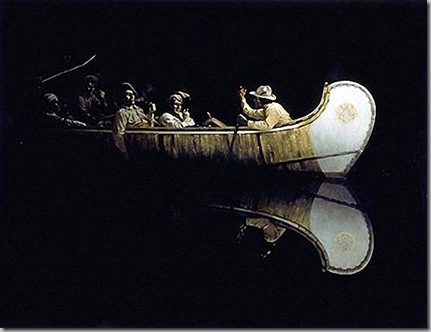
Voyageurs Canadiens vers 1900-1910.
Arthur Heming. Musée Royal de l'Ontario